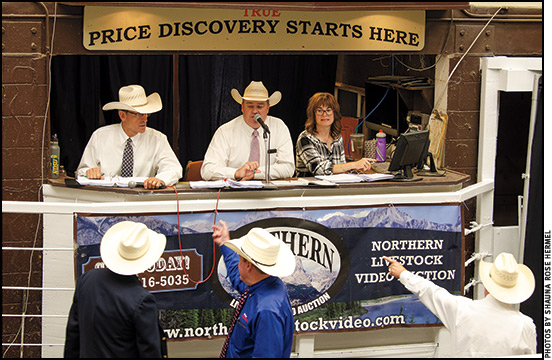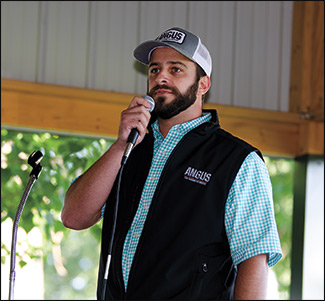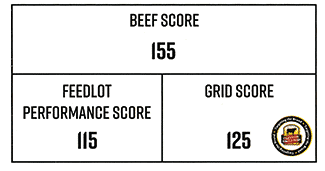
Score
Angus Link scoring system describes genetic potential of feeder cattle, communicating value throughout the system.
Take a half hour to watch a satellite video auction, or sit for an afternoon at a sale featuring load lots of quality calves. Amongst the thousands touted as black on black or even Angus on Angus, how do you know which calves have the genetic potential to perform profitability?
Sure, breed, reputation and history matter, as do vaccination and program status, but they don’t account for the genetic potential — or lack thereof — of the calves or yearlings being sold. A switch in the bull battery can make a huge difference in the performance and grading potential of calves from one calf crop to the next.
Cattle feeders need metrics that align with the traits most valuable to their business, specifically gain and grade, Allen Moczygemba, CEO of the American Angus Association, noted last November as he announced the purchase of Verified Beef, including its Reputation Feeder Cattle program. Moczygemba shared the Association’s intent to build upon the program, utilizing the breed’s comprehensive database, to establish a feeder-cattle program validating the genetic performance potential of calves.
That vision is coming to fruition this summer with the launch of Angus LinkSM. We visited with Chris Engel, director of the Association’s feeder-cattle program, to learn more about the program and what it offers the industry.
What is Angus Link?
Engel: Angus Link is a simple tool that validates the genetic performance potential of feeder cattle. It provides a platform for seedstock breeders to communicate effectively to their bull buyers and those commercial cattlemen to then communicate to people further down the chain the genetic potential those calves have to perform. This enables the commercial sector — both cow-calf producers and feeders — the ability to utilize genetic predictability to increase their profitability.
Who benefits most from the program?
The program is really going to deliver value to everybody in the chain.

Chris Engel says Angus Link serves as a benchmark for commercial cattlemen to measure and track genetic progress as it relates to terminal-based calves destined for the plate.
For the commercial cow-calf man, it serves as a benchmark to measure and track genetic progress as it relates to terminal-based calves destined for the plate. It will allow them to make better decisions, regardless of their familiarity level with EPDs (expected progeny differences) and $Values (dollar value indexes), to make their next calf crop better than the last. Additionally, Angus Link will help them interpret and utilize the tremendous database and minds we have working here at Angus Genetics Inc. (AGI), so they can improve their herds. And, it provides a platform to advertise to potential buyers the genetic merit of their calves.
For the feedlot sector, it offers cattle buyers the ability to incorporate genetic merit into their buying decisions to help further manage risk and make profits more predictable, whether they are paid on gain, grade or a combination of the two. What cattle feeders have told us is that 70% of the U.S. calf crop going through the sale barn is black-hided and there is a tremendous amount of variability in the performance of those cattle when they are fed out and hang on the rail. Even when they are able to identify Angus cattle, there is a large amount of variability in them. They are rolling the dice when they don’t know whether those cattle have the genetic ability to perform profitably in their system.
Angus seedstock breeders gain a tool to assist their commercial customers in improving their herds and marketing their calves. The ultimate goal of the program is to increase the demand for high-quality registered Angus genetics by validating the value of those genetics throughout the industry.

Three scores will be given to each set of calves that are enrolled: beef score, feedlot performance score, and grid score (see Fig. 1). The foundation of the scores are the American Angus Association’s dollar value indexes — $B (beef value), $F (feedlot value) and $G (grid value), respectively. The three Angus Link scores are presented on a scale of 0 to 200, with industry average scoring 100 for each of the three scores.
What are the requirements of the program?
The requirements are pretty simple. A minimum of 50% of the bulls used to sire an enrollment group must be registered Angus bulls. At least 75% of the bulls used to sire an enrollment group must be registered with a breed association, allowing up to 25% of the bulls to be registered with other breed associations. No more than 25% of the bulls used to sire an enrollment group can be non-registered bulls. Semen used for breeding by artificial insemination (AI) will require proof of purchase to be on file.
On the cow side, we need a basic breed description of the herd. It can be as simple as a percentage — 80% Angus, 20% Hereford. However, to make the maternal contribution better reflect the actual genetic merit of the cow herd, we encourage enrollees to provide information on the bulls they have used in the past that have contributed to the genetic makeup of the females they have retained as replacements. In the absence of historical bull information, we assume the cows’ EPDs are in the 75th percentile of the breeds described (bottom 25% of the breed).
Enrollees also need to give us the number of calves they are enrolling and the color of those calves. If the cattle score a 125 grid score or higher and the owner describes their calves as meeting the phenotypic requirements needed to be eligible for branded Angus programs (GLA specification), the enrollment has the opportunity to earn the Certified Angus Beef® (CAB®) brand’s Targeting the Brand logo. That in itself will draw a lot of feeder and buyer attention because it’s a very recognizable and prestigious brand.
We know genetic potential is just potential and management — both on the ranch and at the feedlot — plays a role in an animal’s ability to meet its genetic potential. Cattle that aren’t healthy won’t reach that potential, so, as part of the program, calves are required to receive at least one viral vaccine, one blackleg vaccine and one bacterial vaccine prior to shipment. Users will be able to document if enrollment groups have received more than the minimum requirement and/or utilized a branded health protocol. The vaccine protocol used will appear on the certificate.
What is the cost of enrolling in the program?
Enrollment is $4.50 per head enrolled. As an incentive to encourage early enrollment in Angus Link, participants contributing to the first 50,000 head enrolled will have an introductory enrollment fee of $4 per head, and the 50¢-per-head savings will be reciprocated for each of their sequential enrollment groups if they continue to enroll their calves into the program each year. There is a minimum enrollment of 50 head or a minimum transaction fee of $225.
Participants who plan to dual-enroll in Angus Link and AngusSource® will receive special combination pricing.
How will cattlemen enroll in the program?
Enrollment will be web-based, and intentionally very simple. Similar to AAA Login, users will create an Angus Link username for their account. They will create a Bull Battery listing the bulls they have on hand. They’ll describe the breed composition of the cow herd, along with the number of calves they are enrolling and the vaccine protocol they are following.
They may elect to enroll in one of the process-verified programs, and they can pay their enrollment online.
Enrollees will be required to sign a declaration validating the information they submitted to the best of their knowledge is true and accurate. The American Angus Association will reserve the right to audit enrollees randomly to ensure the information they have provided is accurate in order to maintain the integrity in the program and sustain buyer confidence.
Cattlemen will be able to enroll online at www.anguslink.com.
What marketing assistance can enrollees expect?
If enrollees elect to make their Angus Link marketing certificate public, it will posted online up to 90 days prior to when they plan to sell their calves. Just like AngusSource, Angus Link marketing certificates will be emailed biweekly to cattle feeders and buyers that sign up to receive them. Additionally, prospective buyers can view all enrollments at the program’s website, as well as search for Angus Link-enrolled cattle by region/state, group type or sale organization.
We have also hired two Angus Link field representatives: Casey Cobb and Frank Padilla.
Casey Cobb of Clarendon, Texas, has spent the past 24 years at Hedley Feedlot, the past 12 years serving as the yard’s general manager. His key responsibilities included acquiring cattle and managing customer relationships. He will provide valuable insights from a cattle feeder and buyer perspective and can effectively communicate our program’s value proposition to commercial cow-calf producers.
Frank Padilla has held director positions at both the American Limousin Foundation and the American Gelbvieh Association and has a vast network of relationships within all segments of the beef industry. He will also be able to draw from experience gained at Schroeder Cattle Co. — a unique integrated seedstock and commercial cattle production operation — in Palisade, Neb., where he served as the general manager of operations for 22 years.
Frank and Casey will act as the important “boots on the ground” to help the Angus Link program get off to a strong start.
When will you begin processing enrollments?
Recently we performed a beta enrollment test with 14 producers as part of the Angus Link development phase. Those 14 producers enrolled approximately 4,000 head that were consigned in 19 lots that sold in Northern Livestock Video’s 2018 Summertime Classic Sale and sold on July 23.
Taking advantage of this opportunity presented to staff by Special Feeder Calf Committee Chairman Jerry Connealy proved very beneficial. Manually enrolling and calculating the scores for each enrollment group enabled staff to further refine the web-based enrollment process and the algorithm that will drive the automated scoring once Angus Link goes live in August.







